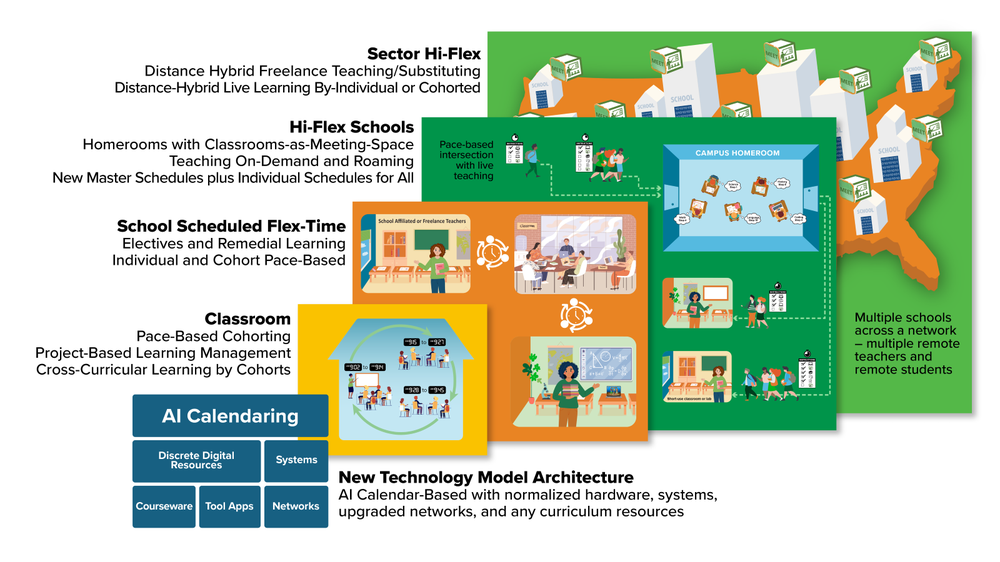More than 2,100 public schools in 25 states have switched to a four-day school week, often in hopes of recruiting teachers, saving money and boosting student attendance, researchers estimate.
It’s not just small, rural schools that have been facing significant teacher shortages, but they have led the trend, usually choosing to take off Mondays or Fridays to give employees and students a three-day weekend every week. To make up for the lost day of instruction, school officials typically tack time onto the remaining four days – extending the school day.
Research into the results of this shift include:
- Less fighting and bullying by as large percentages as 39% in schools.
- About a 20 percent increase in juvenile criminal offenses outside of school because of the extra day off, where the strongest effect is observed for property crime.
- “No detectable effect” on high school attendance or student scores on the ACT college-entrance exam.
- Strong employee support of a compressed workweek, all certified and uncertified teaching and staff – becoming an essential tool to recruit teachers.
- Community/business leaders’ perceptions of the impact of a four-day school week was evenly divided (positive and negative.)
- An extensive review of literature and stakeholder engagement on these topic areas was mostly inconclusive or did not reveal any clear-cut evidence to identify effects of the four-day school week on student outcomes — academic performance, food insecurity or juvenile crime.
- More schools are implementing four-day school weeks to reduce overhead and transportation costs – except the cost savings are so tiny as to be irrelevant. The four-day week requires substantial schedule changes as schools must increase the length of their school day to meet minimum instructional hour requirements.
The Flaws
As you can see, research has tried to figure out the results for students, staff, and the community of a shift in the use of time and space – but only a moderate shift and without a any questions as to what the most important way might be to change how time and space is used given other environmental and cultural trends. Still, basically positive for all concerned, so there is something there. However, the reason why schools are attempting the shift doesn’t hold water since research shows that the maximum possible cost savings for districts on a four-day week is 5.43%, but average savings range from 0.4% to 2.5%. In other words, miniscule.
Savings should be in the neighborhood of at least 20% if it is 1/5th the number of days a school is in operation. Complications are related to requirements for “instructional minutes,” salary packages, testing dates and other crusty archaic policies hemming in how time and space and people intersect to cause learning.
With the first flaw being no discernible reduction in cost, a second flaw is prioritizing teacher recruitment as the determining factor in making the change. There does not appear to be any questioning of what is happening all around schools in the outside world to cause such a massive teacher shortage, expectations of working remotely, and vast attrition of students.
Another serious flaw is that it is actually an act by schools of committing a problem as if it were a solution. For half a century schools have defended their being public users of tax dollars because “both parents work” and low-income families need the supporting diversion of where to have their children while they work. Many educators have lamented the fact that they can’t change anything about schooling because of this need for “babysitting” that schools have come to represent. Yet now, parents have to find childcare for one day a week? This is a cost transferred back to citizens that they were already paying for and is not showing up in savings so there could be a tax cut. It doesn’t make sense.
The most serious flaw is that leaders are not questioning these historical assumptions for a remix that would make a difference:
- Schools assume a linear master schedule, hour-after-hour by whole groups. They have not learned about auto-cohorting algorithms and dynamic time use with the example of Uber.
- Schools assume a teacher for each classroom each hour when “instructional minutes” are not defined as such in any State, and almost no teachers lecture or vocalize instruction the entire time. Instead, there could be a separation of the vocalized instruction and discussion versus the individual study of materials, breaking up the hour. This break up of teacher action versus independent student actions, a vast distinction in most subjects, allows separation in space as well, freeing up the teacher to roam or manage time completely differently with smaller groups.
- Schools assume groupings by age in grades. This assumption that we are all the same at each age has never been strictly true for humanity, differing markedly for certain subjects even between males and females. To add insult to injury, assuming age patterns as the predominant model flies in the face of trying to create equity and diversity so many educators espouse.
- Schools assume groupings are geographically local only, when individual students and teachers might be untethered from locality within a whole district or the whole State to form other, more logical groupings through remote technologies in other patterns of subject and ability. There is no reason that all local students interact only with other local students or that all their teachers are local. A mesh network pattern would only require districts and States effect a new sharing infrastructure of teaching and learner placement.
Algorithms are driving new ideas that include AI doing marvelously transformative things – and not just the consumer query-AI. The good stuff under the hood managing logistics. The type of logistics that make all the assumptions above moot points. Algorithms could be managing logistics for every student and every teacher, creating true pace-based personalization, in the same way Uber puts together a driver and rider or group rides from airports that put together multiple riders going in the same direction with one driver.
Schools do use digital courseware from hundreds of publishers that internally manage auto-cohorting within parameters, and schools run major systems in big data centers. They know logistics are out there, but due to the way they use time and teachers, most of the good stuff that would extend any teacher’s capacity, is “supplemental.” Leaders have confused “teaching” as active lecture or leading discussions occuring for every minute of a classroom hour and insist on it. They have left teaching in the 19th Century by definition, mindless of digital distribution of resources, animated puzzles and quizzes, and activities that purvey learning uniquely by individual.
Worse, highly crafted automated courseware is confused with “all online” and virtual schools when it absolutely should not be. The lower value tool app category is understood, but the courseware that could fully personalize for every learner and dramatically free up teachers to do just important short stints of vocalizing instruction and helping students through stuck points is sidelined.
Flex Learning
Learning can be more flexible in both time and space for any teacher, any school. The new definition of flex learning considers the new culture of remote work, algorithmic calendars, the fully loaded courseware and systems that elevate human teaching by unburdening it to be human. It’s flexible pace logistically managed so that it is not constrained by the old groupings of by-age and by-grade.
Flex learning allows schools to isolate with precision actual teaching from all other activities that teachers have been doing. That precise thing, which if also separated in time and space from those things they do not need to be doing to cause learning like grading and overseeing student discipline and reading and doing worksheets, frees up teaching expertise to be leveraged across more time.
Flex learning is defined as the ability to customize learner pace and place. The student and teacher can participate in lessons or entire courses face-to-face, online, or in hybrid classrooms, any mix of modalities, using the power of the Internet and advanced technologies. Take this vision now beyond the local physical arena to involve other schools, other teachers, a giant mesh network of learning.
The new flex learning humanizes time and space with algorithmic rather than linear schedules that flex to the true diversity of teaching and learning needs.
Teachers are leveraged for their core professional skills – actual teaching. When not doing live teaching, they roam as students study independently with other staff overseeing them, or teachers rotate.
Imagine a Cohorting AI
Like this short video, large rosters of students in any course can be enrolled into the next class meeting moment as they reach the cohort value – in this instance eight (8) students at a time. Imagine this working across all subjects, all grades, in every course, possibly across an entire district or State in a mesh of shared teaching resources. Students could be at points that fit them while still intersecting live in-person with fellow students on physical campuses with some, others arriving virtually in an every-changing mix based on pace. It’s a real solution to learning loss without overburdening teachers.
Flex Learning can be used just for Teachers or Scheduled Flextime or Fully Hi-Flex Schools…and the entire Sector
Teachers can break their large roster into cohorts for core learning, project-based learning and cross-curricular learning. This can be done within one unit or, better, across multiple units (as in the teacher has three 6th grade math classes a day and collapses those hours into one larger block, the three rosters into one, and paces the entire group with auto-cohorting so class meetings fall anywhere in the full three hours.)
Schools can use their already partitioned master schedules with flextime to offer students individually paced learning within that time. This is ideal for electives and remedial learning.
Alternative schools, including full online schools, can use hi-flex master schedules which give a framework for school days while also allowing overlays of individualized schedules for every individual – teachers and students. Small schools managing a breadth of ages and learning levels can ensure live teaching is calendared appropriate to each learner.
Gig teachers and substitutes can be easily plugged into school schedules to take over whole courses. Gig teachers can also offer their own courses which can accrue students to points and automatically schedule the next class, and the next, and so forth.
Most importantly, this vision of flex learning is the logical evolution of the already shifting sands of time and space use schools are having to resort to because they are not built for this age.
For more information: https://thelearningcounsel.com/pages/flex-learning-logistics-project/
***











